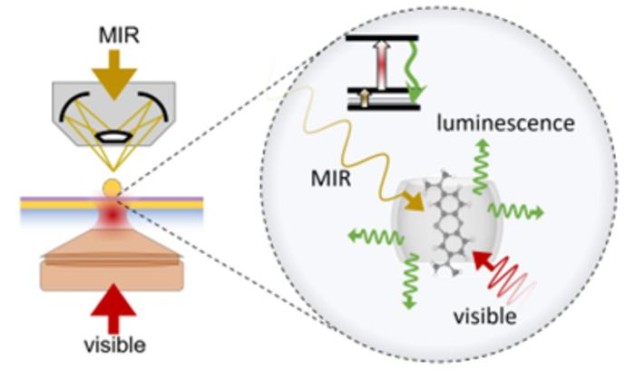
A new, streamlined method of “seeing” vibrations in molecules could have applications in real-time gas sensing, medical imaging, astronomical surveys and even quantum computing. These molecular vibrations occur in the mid-infrared (MIR) range of the electromagnetic spectrum, and the standard way of observing them requires detectors to be cooled to minimize thermal noise due to random high-frequency vibrations of atomic bonds. However, a team of researchers from the universities of Birmingham and Cambridge, UK have now found a way around this requirement by converting low-energy MIR photons into high-energy visible photons.
“Our new ability to see vibrations in individual molecules at room temperature, not possible before, stands out, particularly since such vibrations are typically obscured by thermal noise,” explains the Cambridge nanoscientist Jeremy Baumberg, who led the research effort. According to Rohit Chikkaraddy, a physicist at Birmingham and the first author of a Nature Photonics paper about the technology, the new method could shed light on interactions between lipids and proteins within cells, which are pivotal for understanding cellular functions that depend on molecular vibrations in the MIR range. “Our results pave the way for understanding such molecular dynamics,” Chikkaraddy says.
MIRVAL
In the new method, known as Mid-Infrared Vibrationally-Assisted Luminescence (MIRVAL), the researchers assembled molecules that emit light in the visible range into a photonic structure known as a nanoplasmonic cavity that resonates in both visible and MIR wavelength ranges. This nanoplasmonic cavity is key to the method’s success, Chikkaraddy tells Physics World. “These ultrasmall light-trapping cavities, formed by single-gold-atom defects on metallic defects, allow us to confine visible light into extremely small volumes of less than 1 nm3 and MIR light all the way down to the scale of a single molecule,” he explains.
The team then further engineered this cavity so that the vibrational states of the molecules (which absorb MIR light) and their electronic states (which absorb visible light) were able to interact. “When our system is exposed to visible light with photon energies below the light absorption electronic band, we don’t see any luminescence,” notes Baumberg. “However, when we introduce MIR light as well, the combination of visible and MIR light is sufficient for joint excitation of the molecules to occur which results in visible luminescence.”
In this way, the researchers can upconvert the low-energy MIR light to visible light, allowing them to detect the MIR light, using, for example, advanced silicon cameras like those found in smartphones.
Bringing together three vastly different length scales
One unusual aspect of the technique is that it combines the physics of three different length scales in a single platform. “These are visible wavelengths (of hundreds of nanometres), molecular vibrations (less than a nanometre) and the MIR range (ten thousand nanometres),” Chikkaraddy says.

Frequency upconversion makes infrared light visible
In applications terms, the technique should make it simpler to record the vibrational “fingerprints” of individual molecules at MIR frequencies, he adds. “Through further work this novel method could not only find its way into practical devices that will shape the future of MIR technologies but also unlock the ability to coherently manipulate the intricate interplay of atoms and bonds in molecular quantum systems,” Chikkaraddy says.
The Birmingham-Cambridge researchers say they would now like to apply their technique to more complex systems, including biological entities such as lipid membranes. “This would allow us to observe the molecular dynamics of life in this new spectroscopic window,” says Chikkaraddy.
